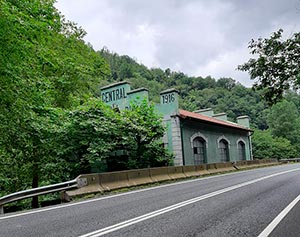Hydroelectric power plants in the Bidasoa basin
Navasturen Power Station (Bera)
The Navasturen power plant is perhaps one of the best known to the public as it is visible next to the N-121-A road, just before the entrance to Bera. The water is derived from a dam on the Bidasoa river located four kilometers away. This project, whose author is the engineer Miguel Berazaluce, was promoted by Saltos del Bidasoa in 1916. The energy was sold exclusively to La Papelera Española, which would end up absorbing the promoting company. The power plant equipment consists of two turbine-generator sets.
The main and rear façades have a stepped finish and the corners are decorated with simulated ashlars. In the main façade -nowadays almost hidden by vegetation- there is a varied rhythm of openings: a linteled entrance door, crowned by a semicircular opening, over which the oculus is located, and flanked on each side by linteled windows, crowned in turn by rectangular-shaped openings. The name of the business, Saltos del Bidasoa, and the year of the inauguration are painted. The conference room of machines is illuminated laterally by three large windows in reduced arch, which are conserved original on the side of the river. The decoration is limited to the upper frames of the openings. It is worth contemplating the riverside landscape, which in this section of the river is of great beauty.
Saltos del Bidasoa also started up two other power plants in Etxalar in 1922. Precisely the Regata de Echalar power station, which stands on the access road to that town a few meters from the hotel Venta Etxalar, is one of the best places to appreciate the complexity of hydroelectric projects, as the diversion canal to Navasturen runs in front of it, which crosses the Tximista stream by means of an aqueduct and then enters a tunnel under the mountain. In addition, the water already turbined in this plant of Regata de Echalar is incorporated into the Navasturen canal.
ALEGRÍA SUESCUN, D., "El molino harinero de Zubieta. Evolución histórica", in Notebooks of ethnology and ethnography of Navarren.º 82 (2007), pp. 5-15.
APEZTEGUÍA ELSO, M. and IRIGARAY SOTO, S., "El Ecomuseo del Molino de Zubieta (Navarra): experiencia pionera en la recuperación y musealización de una instalación preindustrial", in Museum: Magazine of the association Profesional de Museólogos de España (Professional Association of Museologists of Spain)No. 4 (1999), pp. 181-192.
BERAZALUCE ELCARTE, M., "La industria hidro-eléctrica en Navarra", in Rafael Guerra (ed.), Navarra. Ayer, hoy y mañana, Pamplona, Diputación Foral de Navarra, 1933.
HERREROS LOPETEGUI, S. (coord.), Centrales Hidroeléctricas en Navarra (1898-2018), Pamplona, Gobierno de Navarra, 2020.
Map of status based on El agua en Navarra, Pamplona, Caja de Ahorros de Navarra, 1991.











